Occurrence of perfluorinated chemicals (PFCs) in leachate, surface water and sediment collected from Tay Mo landfill and surrounding areas
The municipal landfill is considered to be a potential source of different environmental contaminants derived from
consumer goods, including perfluorinated chemicals (PFCs). Twenty-four leachate, surface water samples and twentyfour sediment samples collected at Tay Mo landfill (Hanoi, Vietnam) and surrounding areas were analysed for sixteen
PFCs. Total concentrations of PFCs in leachate and surface water ranged from 103 to 328 ng/L (mean: 161 ng/L) at Tay
Mo landfill, 19.1-22.4 ng/L (mean: 20.7 ng/L) in ponds nearby the landfill, 5.19-6.96 ng/L (mean: 5.96 ng/L) in Nhue
River around the landfill, 5.57-12.7 ng/L (mean: 9.00 ng/L) in the upstream and 3.81-11.5 ng/L (mean: 7.14 ng/L) in the
downstream. The total concentrations of PFCs in landfill sediment which ranged from 3.52 to 6.70 ng/g (mean: 5 ng/g)
was 3-4 times higher than those in sediment taken from Nhue River and the ponds around the landfill. The dominating
detected compounds were short-chain perfluorinated alkyl substances like PFOA, PFHxA, PFHpA in water, and PFOS,
PFBS in sediment.
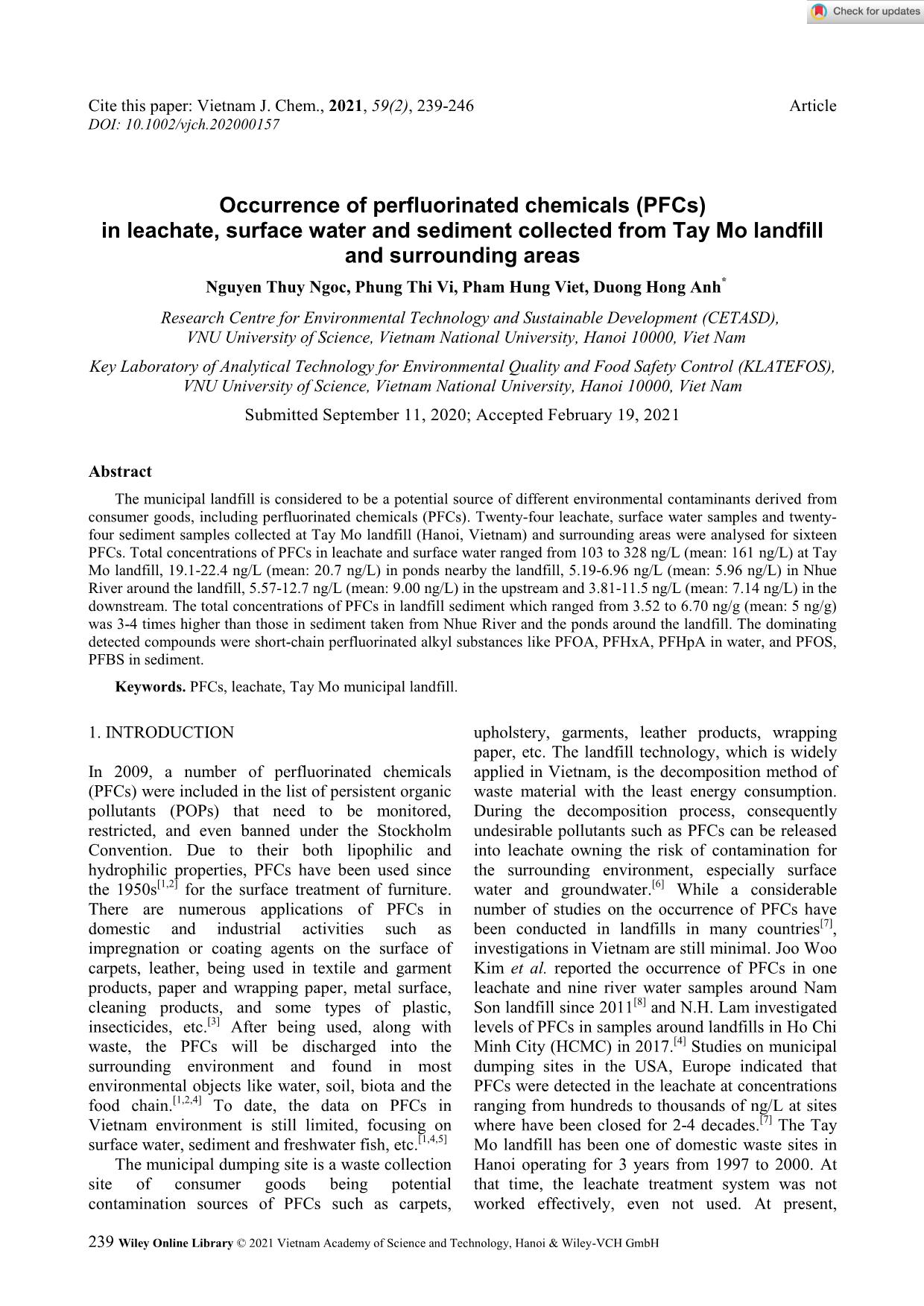
Trang 1
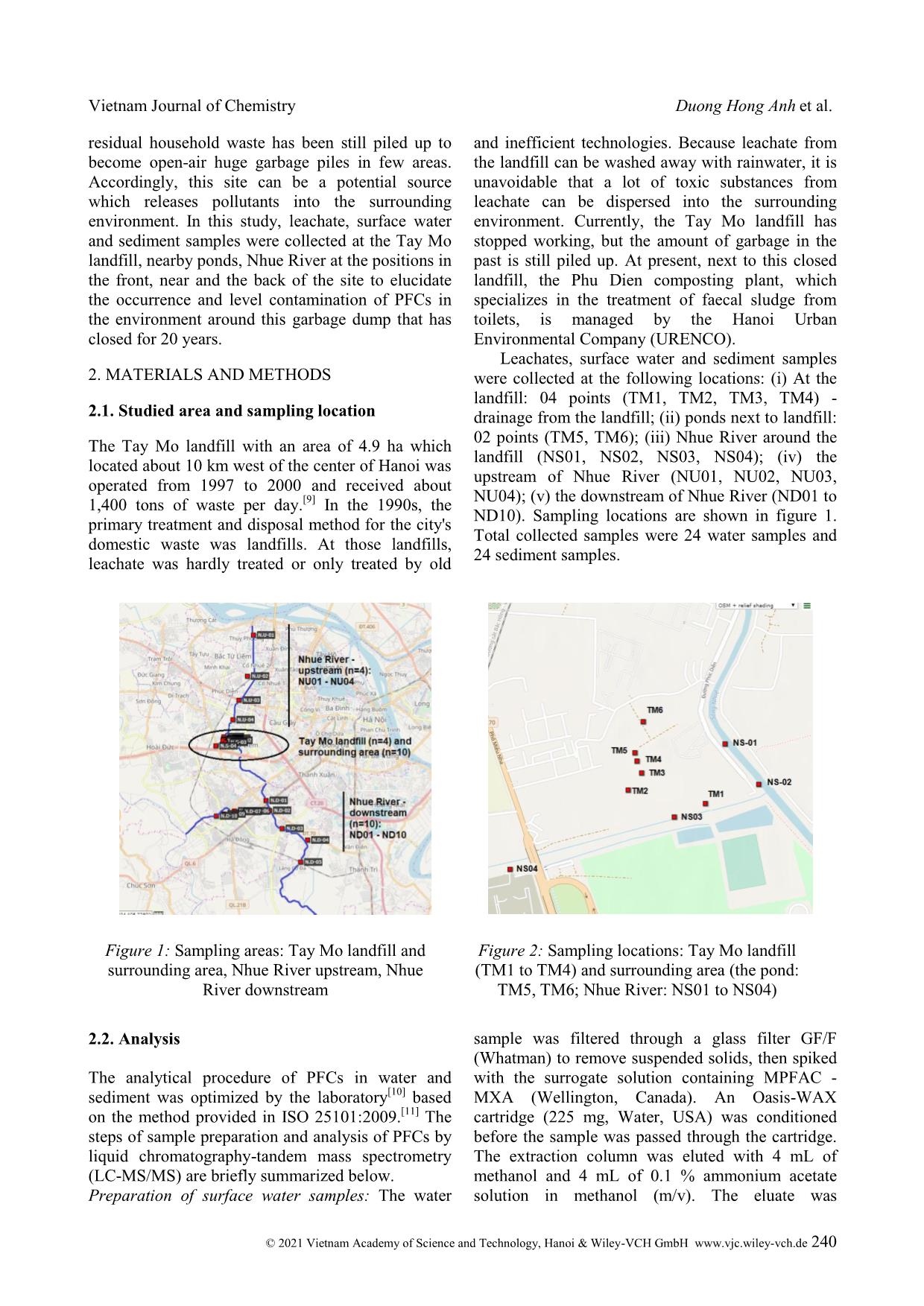
Trang 2
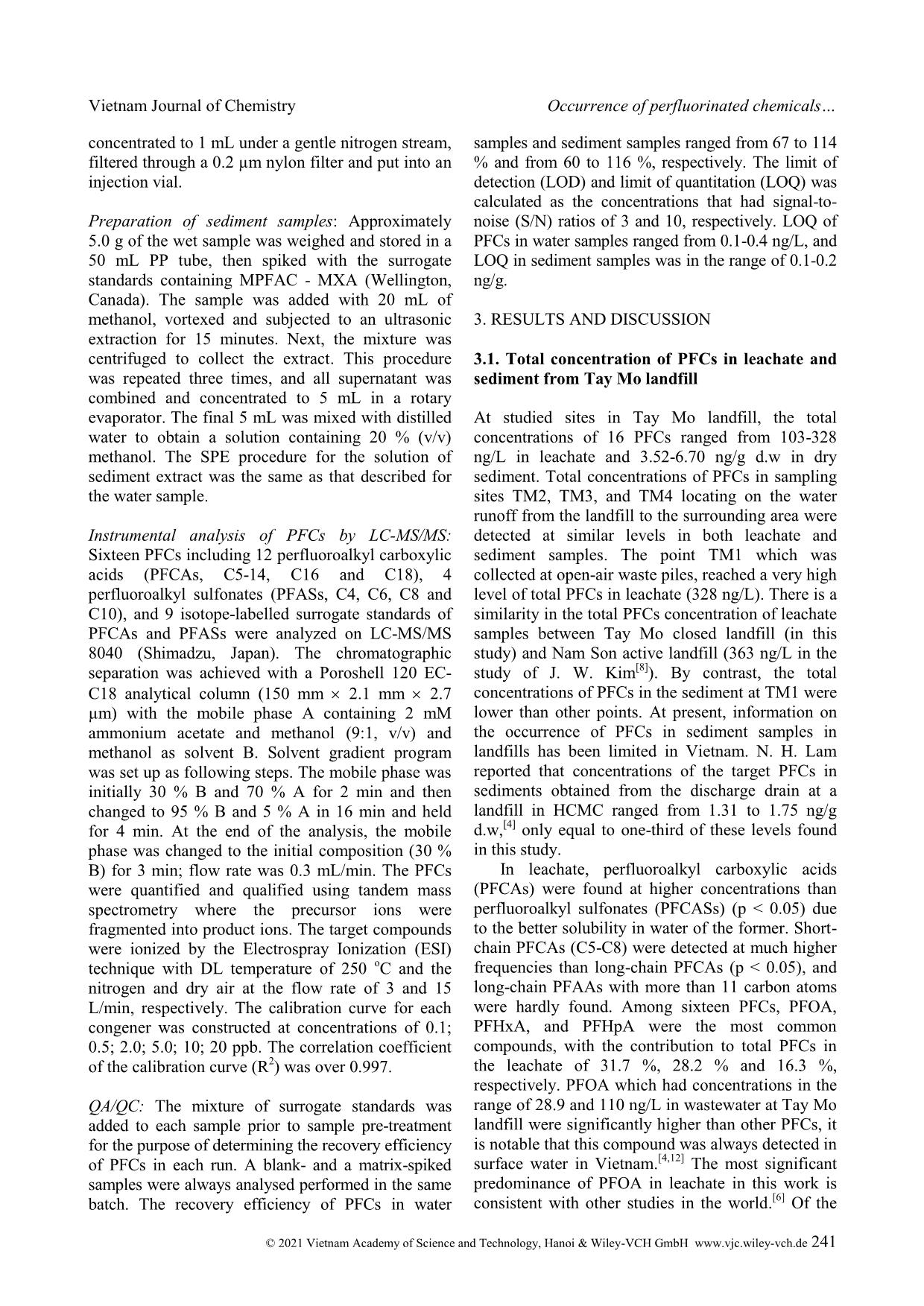
Trang 3

Trang 4

Trang 5
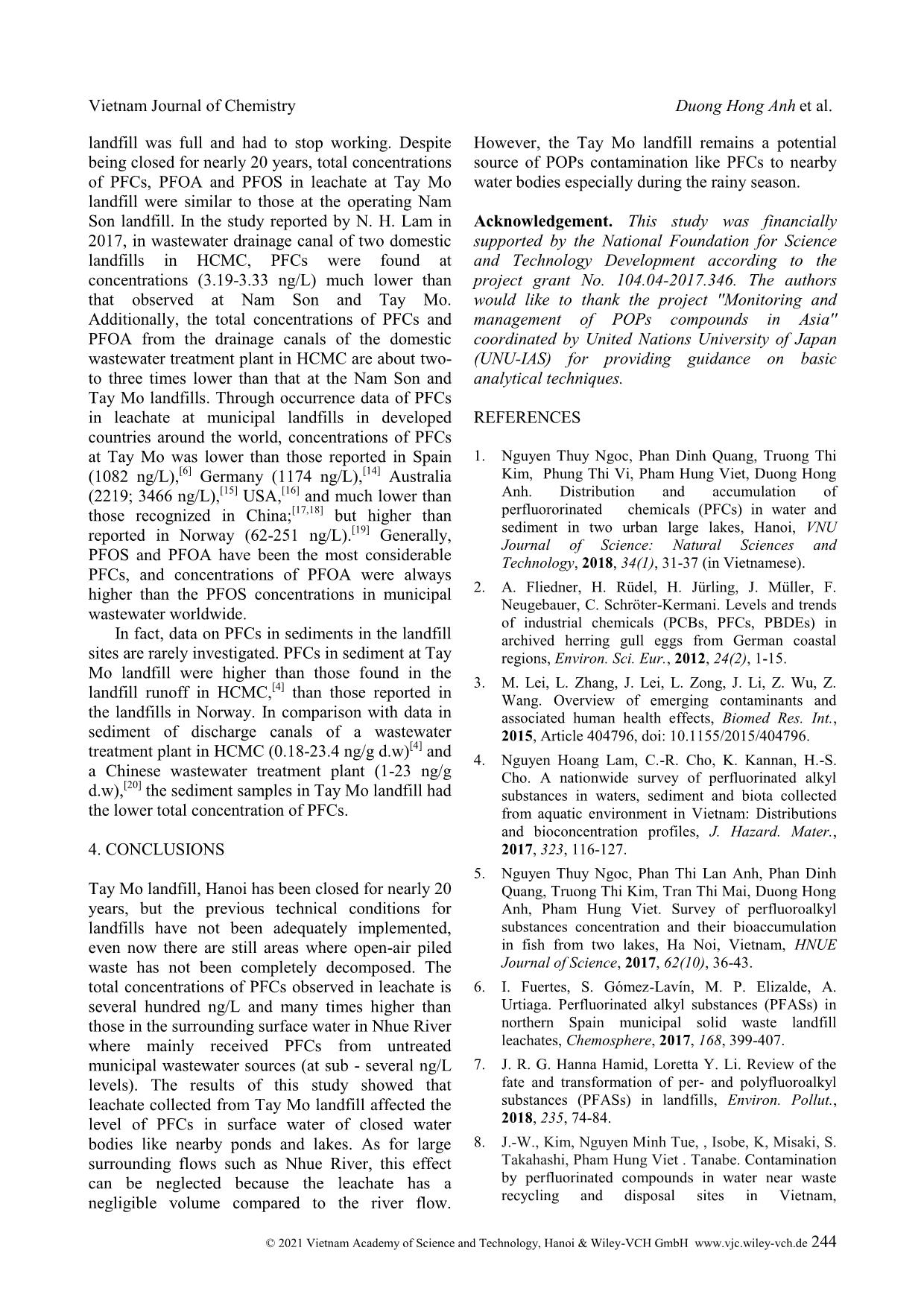
Trang 6
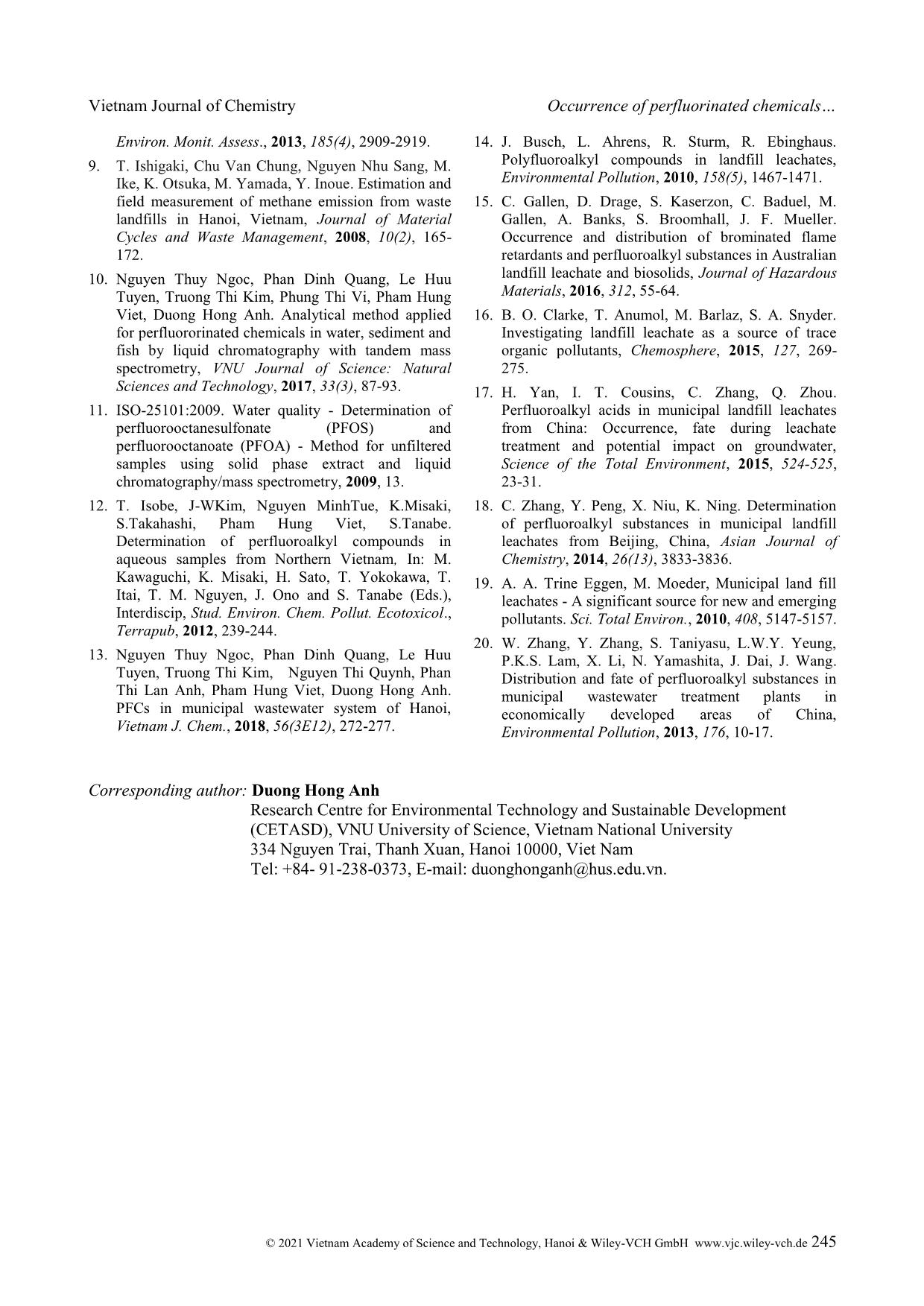
Trang 7
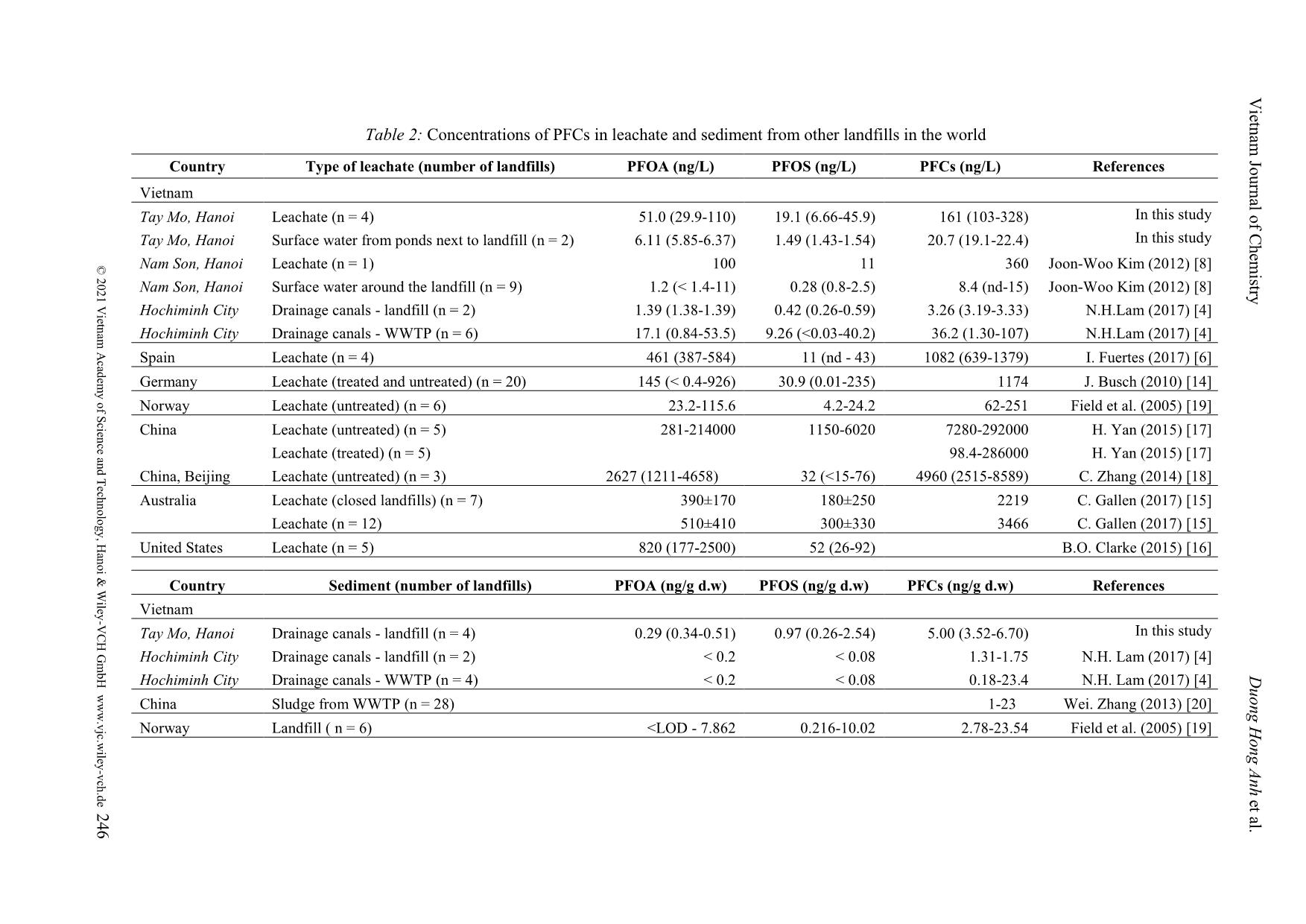
Trang 8
Tóm tắt nội dung tài liệu: Occurrence of perfluorinated chemicals (PFCs) in leachate, surface water and sediment collected from Tay Mo landfill and surrounding areas
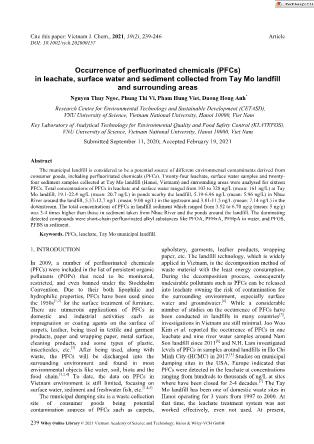
Cite this paper: Vietnam J. Chem., 2021, 59(2), 239-246 Article DOI: 10.1002/vjch.202000157 239 Wiley Online Library © 2021 Vietnam Academy of Science and Technology, Hanoi & Wiley-VCH GmbH Occurrence of perfluorinated chemicals (PFCs) in leachate, surface water and sediment collected from Tay Mo landfill and surrounding areas Nguyen Thuy Ngoc, Phung Thi Vi, Pham Hung Viet, Duong Hong Anh * Research Centre for Environmental Technology and Sustainable Development (CETASD), VNU University of Science, Vietnam National University, Hanoi 10000, Viet Nam Key Laboratory of Analytical Technology for Environmental Quality and Food Safety Control (KLATEFOS), VNU University of Science, Vietnam National University, Hanoi 10000, Viet Nam Submitted September 11, 2020; Accepted February 19, 2021 Abstract The municipal landfill is considered to be a potential source of different environmental contaminants derived from consumer goods, including perfluorinated chemicals (PFCs). Twenty-four leachate, surface water samples and twenty- four sediment samples collected at Tay Mo landfill (Hanoi, Vietnam) and surrounding areas were analysed for sixteen PFCs. Total concentrations of PFCs in leachate and surface water ranged from 103 to 328 ng/L (mean: 161 ng/L) at Tay Mo landfill, 19.1-22.4 ng/L (mean: 20.7 ng/L) in ponds nearby the landfill, 5.19-6.96 ng/L (mean: 5.96 ng/L) in Nhue River around the landfill, 5.57-12.7 ng/L (mean: 9.00 ng/L) in the upstream and 3.81-11.5 ng/L (mean: 7.14 ng/L) in the downstream. The total concentrations of PFCs in landfill sediment which ranged from 3.52 to 6.70 ng/g (mean: 5 ng/g) was 3-4 times higher than those in sediment taken from Nhue River and the ponds around the landfill. The dominating detected compounds were short-chain perfluorinated alkyl substances like PFOA, PFHxA, PFHpA in water, and PFOS, PFBS in sediment. Keywords. PFCs, leachate, Tay Mo municipal landfill. 1. INTRODUCTION In 2009, a number of perfluorinated chemicals (PFCs) were included in the list of persistent organic pollutants (POPs) that need to be monitored, restricted, and even banned under the Stockholm Convention. Due to their both lipophilic and hydrophilic properties, PFCs have been used since the 1950s [1,2] for the surface treatment of furniture. There are numerous applications of PFCs in domestic and industrial activities such as impregnation or coating agents on the surface of carpets, leather, being used in textile and garment products, paper and wrapping paper, metal surface, cleaning products, and some types of plastic, insecticides, etc. [3] After being used, along with waste, the PFCs will be discharged into the surrounding environment and found in most environmental objects like water, soil, biota and the food chain. [1,2,4] To date, the data on PFCs in Vietnam environment is still limited, focusing on surface water, sediment and freshwater fish, etc. [1,4,5] The municipal dumping site is a waste collection site of consumer goods being potential contamination sources of PFCs such as carpets, upholstery, garments, leather products, wrapping paper, etc. The landfill technology, which is widely applied in Vietnam, is the decomposition method of waste material with the least energy consumption. During the decomposition process, consequently undesirable pollutants such as PFCs can be released into leachate owning the risk of contamination for the surrounding environment, especially surface water and groundwater. [6] While a considerable number of studies on the occurrence of PFCs have been conducted in landfills in many countries [7] , investigations in Vietnam are still minimal. Joo Woo Kim et al. reported the occurrence of PFCs in one leachate and nine river water samples around Nam Son landfill since 2011 [8] and N.H. Lam investigated levels of PFCs in samples around landfills in Ho Chi Minh City (HCMC) in 2017. [4] Studies on municipal dumping sites in the USA, Europe indicated that PFCs were detected in the leachate at concentrations ranging from hundreds to thousands of ng/L at sites where have been closed for 2-4 decades. [7] The Tay Mo landfill has been one of domestic waste sites in Hanoi operating for 3 years from 1997 to 2000. At that time, the leachate treatment system was not worked effectively, even not used. At present, Vietnam Journal of Chemistry Duong Hong Anh et al. © 2021 Vietnam Academy of Science and Technology, Hanoi & Wiley-VCH GmbH www.vjc.wiley-vch.de 240 residual household waste has been still piled up to become open-air huge garbage piles in few areas. Accordingly, this site can be a potential source which releases pollutants into the surrounding environment. In this study, leachate, surface water and sediment samples were collected at the Tay Mo landfill, nearby ponds, Nhue River at the positions in the front, near and the back of the site to elucidate the occurrence and level contamination of PFCs in the environment around this garbage dump that has closed for 20 years. 2. MATERIALS AND METHODS 2.1. Studied area and sampling location The Tay Mo landfill with an area of 4.9 ha which located about 10 km west of the center of Hanoi was operated from 1997 to 2000 and received about 1,400 tons of waste per day. [9] In the 1990s, the primary treatment and disposal method for the city's domestic waste was landfills. At those landfills, leachate was hardly treated or only treated by old and inefficient technologies. Because leachate from the landfill can be washed away with rainwater, it is unavoidable that a lot of toxic substances from leachate can be dispersed into the surrounding environment. Currently, the Tay Mo landfill has stopped working, but the amount of garbage in the past is still piled up. At present, next to this closed landfill, ... n Tay Mo landfill on the presence of PFCs in water samples taken in Nhue River at the time of sampling (dry season) was not observed. At the landfill and two ponds next to there, PFOA and PFOS were detected with the detection frequency of 100 %. For surface water samples collected from Nhue River, while PFOS was found at a lower frequency (61 %), PFOA was observed in all samples and had the highest concentration among PFCs. The PFCs concentrations in Nhue River water were similar to the results obtained in our previous studies on the wastewater in the drainage system in central Hanoi (Kim Nguu River, To Lich River, Yen So Lake) with the total concentration of PFCs ranging from 4 to 10 ng/L in the dry season and there was no difference between upstream and downstream. [13] Although there are seven municipal wastewater treatment plants which have currently worked in Hanoi, it is the fact that approximately three fourth of wastewater amount from domestic activities and production has been discharged directly into this river and lake systems without sufficient treatment. Figure 5: Total concentration of PFCs in leachate, surface water and sediment at Tay Mo landfill compared to other investigated areas At the Tay Mo landfill, the average total concentrations of PFCs found in sediment (5 ng/g) were three- to four-fold greater than those in Nhue river (1.57 ng/g) and the ponds surrounding the landfill (1.34 ng/g), respectively. However, the comparison within result sets showed no statistically meaningful difference between samples collected at the landfill and other investigation areas. Analysis results indicated that, despite being closed, the Tay Mo landfill might be a potential source of PFCs that pre-existed or emerged by the decomposition of residual waste, probably affecting closed water bodies (like ponds) next to there. 3.4. Comparison of PFCs concentrations in wastewater and sediment from different dumping sites A variety of data on PFCs at landfill obtained in this study and other publications are summarized in table 2. The presence of PFCs in the wastewater and leachate is of great concern in many countries around the world, but in Vietnam, the data of PFCs in wastewater and leachate is still limited. The first literature published by J. W. Kim et al. in 2012 [8] showed that the total concentration of PFCs, PFOA and PFOS in leachate in Nam Son landfill in Hanoi were 360, 100 and 11 ng/L, respectively. The Nam Son landfill was put into operation after the Tay Mo Vietnam Journal of Chemistry Duong Hong Anh et al. © 2021 Vietnam Academy of Science and Technology, Hanoi & Wiley-VCH GmbH www.vjc.wiley-vch.de 244 landfill was full and had to stop working. Despite being closed for nearly 20 years, total concentrations of PFCs, PFOA and PFOS in leachate at Tay Mo landfill were similar to those at the operating Nam Son landfill. In the study reported by N. H. Lam in 2017, in wastewater drainage canal of two domestic landfills in HCMC, PFCs were found at concentrations (3.19-3.33 ng/L) much lower than that observed at Nam Son and Tay Mo. Additionally, the total concentrations of PFCs and PFOA from the drainage canals of the domestic wastewater treatment plant in HCMC are about two- to three times lower than that at the Nam Son and Tay Mo landfills. Through occurrence data of PFCs in leachate at municipal landfills in developed countries around the world, concentrations of PFCs at Tay Mo was lower than those reported in Spain (1082 ng/L), [6] Germany (1174 ng/L), [14] Australia (2219; 3466 ng/L), [15] USA, [16] and much lower than those recognized in China; [17,18] but higher than reported in Norway (62-251 ng/L). [19] Generally, PFOS and PFOA have been the most considerable PFCs, and concentrations of PFOA were always higher than the PFOS concentrations in municipal wastewater worldwide. In fact, data on PFCs in sediments in the landfill sites are rarely investigated. PFCs in sediment at Tay Mo landfill were higher than those found in the landfill runoff in HCMC, [4] than those reported in the landfills in Norway. In comparison with data in sediment of discharge canals of a wastewater treatment plant in HCMC (0.18-23.4 ng/g d.w) [4] and a Chinese wastewater treatment plant (1-23 ng/g d.w), [20] the sediment samples in Tay Mo landfill had the lower total concentration of PFCs. 4. CONCLUSIONS Tay Mo landfill, Hanoi has been closed for nearly 20 years, but the previous technical conditions for landfills have not been adequately implemented, even now there are still areas where open-air piled waste has not been completely decomposed. The total concentrations of PFCs observed in leachate is several hundred ng/L and many times higher than those in the surrounding surface water in Nhue River where mainly received PFCs from untreated municipal wastewater sources (at sub - several ng/L levels). The results of this study showed that leachate collected from Tay Mo landfill affected the level of PFCs in surface water of closed water bodies like nearby ponds and lakes. As for large surrounding flows such as Nhue River, this effect can be neglected because the leachate has a negligible volume compared to the river flow. However, the Tay Mo landfill remains a potential source of POPs contamination like PFCs to nearby water bodies especially during the rainy season. Acknowledgement. This study was financially supported by the National Foundation for Science and Technology Development according to the project grant No. 104.04-2017.346. The authors would like to thank the project ''Monitoring and management of POPs compounds in Asia'' coordinated by United Nations University of Japan (UNU-IAS) for providing guidance on basic analytical techniques. REFERENCES 1. Nguyen Thuy Ngoc, Phan Dinh Quang, Truong Thi Kim, Phung Thi Vi, Pham Hung Viet, Duong Hong Anh. Distribution and accumulation of perfluororinated chemicals (PFCs) in water and sediment in two urban large lakes, Hanoi, VNU Journal of Science: Natural Sciences and Technology, 2018, 34(1), 31-37 (in Vietnamese). 2. A. Fliedner, H. Rüdel, H. Jürling, J. Müller, F. Neugebauer, C. Schröter-Kermani. Levels and trends of industrial chemicals (PCBs, PFCs, PBDEs) in archived herring gull eggs from German coastal regions, Environ. Sci. Eur., 2012, 24(2), 1-15. 3. M. Lei, L. Zhang, J. Lei, L. Zong, J. Li, Z. Wu, Z. Wang. Overview of emerging contaminants and associated human health effects, Biomed Res. Int., 2015, Article 404796, doi: 10.1155/2015/404796. 4. Nguyen Hoang Lam, C.-R. Cho, K. Kannan, H.-S. Cho. A nationwide survey of perfluorinated alkyl substances in waters, sediment and biota collected from aquatic environment in Vietnam: Distributions and bioconcentration profiles, J. Hazard. Mater., 2017, 323, 116-127. 5. Nguyen Thuy Ngoc, Phan Thi Lan Anh, Phan Dinh Quang, Truong Thi Kim, Tran Thi Mai, Duong Hong Anh, Pham Hung Viet. Survey of perfluoroalkyl substances concentration and their bioaccumulation in fish from two lakes, Ha Noi, Vietnam, HNUE Journal of Science, 2017, 62(10), 36-43. 6. I. Fuertes, S. Gómez-Lavín, M. P. Elizalde, A. Urtiaga. Perfluorinated alkyl substances (PFASs) in northern Spain municipal solid waste landfill leachates, Chemosphere, 2017, 168, 399-407. 7. J. R. G. Hanna Hamid, Loretta Y. Li. Review of the fate and transformation of per- and polyfluoroalkyl substances (PFASs) in landfills, Environ. Pollut., 2018, 235, 74-84. 8. J.-W., Kim, Nguyen Minh Tue, , Isobe, K, Misaki, S. Takahashi, Pham Hung Viet . Tanabe. Contamination by perfluorinated compounds in water near waste recycling and disposal sites in Vietnam, Vietnam Journal of Chemistry Occurrence of perfluorinated chemicals © 2021 Vietnam Academy of Science and Technology, Hanoi & Wiley-VCH GmbH www.vjc.wiley-vch.de 245 Environ. Monit. Assess., 2013, 185(4), 2909-2919. 9. T. Ishigaki, Chu Van Chung, Nguyen Nhu Sang, M. Ike, K. Otsuka, M. Yamada, Y. Inoue. Estimation and field measurement of methane emission from waste landfills in Hanoi, Vietnam, Journal of Material Cycles and Waste Management, 2008, 10(2), 165- 172. 10. Nguyen Thuy Ngoc, Phan Dinh Quang, Le Huu Tuyen, Truong Thi Kim, Phung Thi Vi, Pham Hung Viet, Duong Hong Anh. Analytical method applied for perfluororinated chemicals in water, sediment and fish by liquid chromatography with tandem mass spectrometry, VNU Journal of Science: Natural Sciences and Technology, 2017, 33(3), 87-93. 11. ISO-25101:2009. Water quality - Determination of perfluorooctanesulfonate (PFOS) and perfluorooctanoate (PFOA) - Method for unfiltered samples using solid phase extract and liquid chromatography/mass spectrometry, 2009, 13. 12. T. Isobe, J-WKim, Nguyen MinhTue, K.Misaki, S.Takahashi, Pham Hung Viet, S.Tanabe. Determination of perfluoroalkyl compounds in aqueous samples from Northern Vietnam, In: M. Kawaguchi, K. Misaki, H. Sato, T. Yokokawa, T. Itai, T. M. Nguyen, J. Ono and S. Tanabe (Eds.), Interdiscip, Stud. Environ. Chem. Pollut. Ecotoxicol., Terrapub, 2012, 239-244. 13. Nguyen Thuy Ngoc, Phan Dinh Quang, Le Huu Tuyen, Truong Thi Kim, Nguyen Thi Quynh, Phan Thi Lan Anh, Pham Hung Viet, Duong Hong Anh. PFCs in municipal wastewater system of Hanoi, Vietnam J. Chem., 2018, 56(3E12), 272-277. 14. J. Busch, L. Ahrens, R. Sturm, R. Ebinghaus. Polyfluoroalkyl compounds in landfill leachates, Environmental Pollution, 2010, 158(5), 1467-1471. 15. C. Gallen, D. Drage, S. Kaserzon, C. Baduel, M. Gallen, A. Banks, S. Broomhall, J. F. Mueller. Occurrence and distribution of brominated flame retardants and perfluoroalkyl substances in Australian landfill leachate and biosolids, Journal of Hazardous Materials, 2016, 312, 55-64. 16. B. O. Clarke, T. Anumol, M. Barlaz, S. A. Snyder. Investigating landfill leachate as a source of trace organic pollutants, Chemosphere, 2015, 127, 269- 275. 17. H. Yan, I. T. Cousins, C. Zhang, Q. Zhou. Perfluoroalkyl acids in municipal landfill leachates from China: Occurrence, fate during leachate treatment and potential impact on groundwater, Science of the Total Environment, 2015, 524-525, 23-31. 18. C. Zhang, Y. Peng, X. Niu, K. Ning. Determination of perfluoroalkyl substances in municipal landfill leachates from Beijing, China, Asian Journal of Chemistry, 2014, 26(13), 3833-3836. 19. A. A. Trine Eggen, M. Moeder, Municipal land fill leachates - A significant source for new and emerging pollutants. Sci. Total Environ., 2010, 408, 5147-5157. 20. W. Zhang, Y. Zhang, S. Taniyasu, L.W.Y. Yeung, P.K.S. Lam, X. Li, N. Yamashita, J. Dai, J. Wang. Distribution and fate of perfluoroalkyl substances in municipal wastewater treatment plants in economically developed areas of China, Environmental Pollution, 2013, 176, 10-17. Corresponding author: Duong Hong Anh Research Centre for Environmental Technology and Sustainable Development (CETASD), VNU University of Science, Vietnam National University 334 Nguyen Trai, Thanh Xuan, Hanoi 10000, Viet Nam Tel: +84- 91-238-0373, E-mail: duonghonganh@hus.edu.vn. Table 2: Concentrations of PFCs in leachate and sediment from other landfills in the world Country Type of leachate (number of landfills) PFOA (ng/L) PFOS (ng/L) PFCs (ng/L) References Vietnam Tay Mo, Hanoi Leachate (n = 4) 51.0 (29.9-110) 19.1 (6.66-45.9) 161 (103-328) In this study Tay Mo, Hanoi Surface water from ponds next to landfill (n = 2) 6.11 (5.85-6.37) 1.49 (1.43-1.54) 20.7 (19.1-22.4) In this study Nam Son, Hanoi Leachate (n = 1) 100 11 360 Joon-Woo Kim (2012) [8] Nam Son, Hanoi Surface water around the landfill (n = 9) 1.2 (< 1.4-11) 0.28 (0.8-2.5) 8.4 (nd-15) Joon-Woo Kim (2012) [8] Hochiminh City Drainage canals - landfill (n = 2) 1.39 (1.38-1.39) 0.42 (0.26-0.59) 3.26 (3.19-3.33) N.H.Lam (2017) [4] Hochiminh City Drainage canals - WWTP (n = 6) 17.1 (0.84-53.5) 9.26 (<0.03-40.2) 36.2 (1.30-107) N.H.Lam (2017) [4] Spain Leachate (n = 4) 461 (387-584) 11 (nd - 43) 1082 (639-1379) I. Fuertes (2017) [6] Germany Leachate (treated and untreated) (n = 20) 145 (< 0.4-926) 30.9 (0.01-235) 1174 J. Busch (2010) [14] Norway Leachate (untreated) (n = 6) 23.2-115.6 4.2-24.2 62-251 Field et al. (2005) [19] China Leachate (untreated) (n = 5) 281-214000 1150-6020 7280-292000 H. Yan (2015) [17] Leachate (treated) (n = 5) 98.4-286000 H. Yan (2015) [17] China, Beijing Leachate (untreated) (n = 3) 2627 (1211-4658) 32 (<15-76) 4960 (2515-8589) C. Zhang (2014) [18] Australia Leachate (closed landfills) (n = 7) 390±170 180±250 2219 C. Gallen (2017) [15] Leachate (n = 12) 510±410 300±330 3466 C. Gallen (2017) [15] United States Leachate (n = 5) 820 (177-2500) 52 (26-92) B.O. Clarke (2015) [16] Country Sediment (number of landfills) PFOA (ng/g d.w) PFOS (ng/g d.w) PFCs (ng/g d.w) References Vietnam Tay Mo, Hanoi Drainage canals - landfill (n = 4) 0.29 (0.34-0.51) 0.97 (0.26-2.54) 5.00 (3.52-6.70) In this study Hochiminh City Drainage canals - landfill (n = 2) < 0.2 < 0.08 1.31-1.75 N.H. Lam (2017) [4] Hochiminh City Drainage canals - WWTP (n = 4) < 0.2 < 0.08 0.18-23.4 N.H. Lam (2017) [4] China Sludge from WWTP (n = 28) 1-23 Wei. Zhang (2013) [20] Norway Landfill ( n = 6) <LOD - 7.862 0.216-10.02 2.78-23.54 Field et al. (2005) [19] © 2 0 2 1 V ietn am A cad em y o f S cien ce an d T ech n o lo g y , H an o i & W iley -V C H G m b H w w w .v jc.w iley -v ch .d e 2 4 6 V ietn am Jo u rn al o f C h em istry D u o n g H o n g A n h et al.
File đính kèm:
 occurrence_of_perfluorinated_chemicals_pfcs_in_leachate_surf.pdf
occurrence_of_perfluorinated_chemicals_pfcs_in_leachate_surf.pdf

